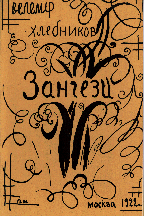Zaum

Zaum (Russian: зáумь) is a word used to describe the linguistic experiments in sound symbolism and language creation of Russian Futurist poets such as Velimir Khlebnikov and Aleksei Kruchenykh.
Coined by Kruchenykh in 1913,[1] the word zaum is made up of the Russian prefix за "beyond, behind" and noun ум "the mind, nous" and has been translated as "transreason", "transration" or "beyonsense" (Paul Schmidt).[2] According to scholar Gerald Janecek, zaum can be defined as experimental poetic language characterized by indeterminacy in meaning.[3]
Kruchenykh, in “Declaration of the Word as Such (1913),” declares zaum “a language which does not have any definite meaning, a transrational language” that “allows for fuller expression” whereas, he maintains, the common language of everyday speech “binds.”[4] He further maintained, in “Declaration of Transrational Language (1921),” that zaum “can provide a universal poetic language, born organically, and not artificially, like Esperanto."[5]
Examples of zaum include Kruchenykh's poem "dyr bul schyl,"[6] Kruchenykh's libretto for the Futurist opera Victory over the Sun with music by Mikhail Matyushin and stage design by Kazimir Malevich,[7] and Khlebnikov's so-called "language of the birds", "language of the gods" and "language of the stars".[8]The poetic output is perhaps comparable to that of the contemporary Dadaism but the linguistic theory or metaphysics behind zaum was entirely devoid of the gentle self-irony of that movement and in all seriousness intended to recover the sound symbolism of a lost aboriginal tongue.[9] Exhibiting traits of a Slavic national mysticism, Kruchenykh aimed at recovering the primeval Slavic mother-tongue in particular.
In modern times, contemporary avant-garde poet Sergei Biriukov has founded an association of poets called the "Academy of Zaum" in Tambov. Other practitioners of zaum poetry include Serge Segay and Rea Nikonova.
The use of Zaum peaked from 1916 to 1920 during World War I. At this time, Zaumism took root as a movement primarily involved in visual arts, literature, poetry, art manifestoes, art theory, theatre, and graphic design,[10] and concentrated its anti war politic through a rejection of the prevailing standards in art through anti-art cultural works. Zaum activities included public gatherings, demonstrations, and publications. The movement influenced later styles, Avant-garde and downtown music movements, and groups including surrealism, nouveau réalisme, Pop Art and Fluxus.[11]
See also
Notes
- ↑ Janecek, Gerald. Zaum: The Transrational Poetry of Russian Futurism. San Diego: San Diego State University Press, 1996: 2. ISBN 978-1879691414
- ↑ Janecek, Gerald. Zaum: The Transrational Poetry of Russian Futurism. San Diego: San Diego State University Press, 1996: 1. ISBN 978-1879691414
- ↑ Janecek, Gerald. Zaum: The Transrational Poetry of Russian Futurism. San Diego: San Diego State University Press, 1996: 1. ISBN 978-1879691414
- ↑ Janecek, Gerald. Zaum: The Transrational Poetry of Russian Futurism. San Diego: San Diego State University Press, 1996: 78. ISBN 978-1879691414
- ↑ Kruchenykh, Aleksei. "Declaration of Transrational Language" in Anna Lawton and Herbert Eagle, Translators and Editors. Words in Revolution: Russian Futurist Manifestoes 1912-1928. Washington: New Academia Publishing, 2005: 183. ISBN 978-0974493473
- ↑ Janecek, Gerald. Zaum: The Transrational Poetry of Russian Futurism. San Diego: San Diego State University Press, 1996: 49. ISBN 978-1879691414
- ↑ Janecek, Gerald. Zaum: The Transrational Poetry of Russian Futurism. San Diego: San Diego State University Press, 1996: 111. ISBN 978-1879691414
- ↑ Janecek, Gerald. Zaum: The Transrational Poetry of Russian Futurism. San Diego: San Diego State University Press, 1996: 137-138. ISBN 978-1879691414
- ↑ Janecek, Gerald. Zaum: The Transrational Poetry of Russian Futurism. San Diego: San Diego State University Press, 1996: 79. ISBN 978-1879691414
- ↑ Janecek, Gerald. The Look of Russian Literature: Avant-Garde Visual Experiments 1900-1930. Princeton: Princeton University Press, 1984: 149-206. ISBN 978-0691014579
- ↑ Knowlson J. (1996). The Continuing Influence of Zaum. London: Bloomsbury. p. 217.
References
- Janecek, Gerald. The Look of Russian Literature: Avant-Garde Visual Experiments 1900-1930. Princeton: Princeton University Press, 1984. ISBN 978-0691014579
- Janecek, Gerald. Zaum: The Transrational Poetry of Russian Futurism. San Diego: San Diego State University Press, 1996. ISBN 978-1879691414
- Kruchenykh, Aleksei. "Declaration of Transrational Language" in Anna Lawton and Herbert Eagle, Translators and Editors. Words in Revolution: Russian Futurist Manifestoes 1912-1928. Washington: New Academia Publishing, 2005. ISBN 978-0974493473
External links
- Chapter Nine of G. Janecek, Zaum: The Transrational Poetry of Russian Futurism
- Janecek's Zaum, published by San Diego State University Press
- Lecture by Z. Laskewicz: “Zaum: Words Without Meaning or Meaning Without Words? Towards a Musical Understanding of Language”
- 'Locating Zaum: Mnatsakanova on Khlebnikov' an essay by Brian Reed
- Article by A. Purin: “Meaning and Zaum” (Russian)
- Tambov Academy of Zaum, Cyrillic KOI8-R encoding (Russian)